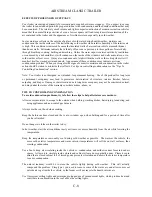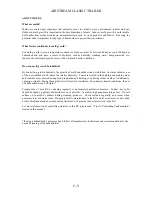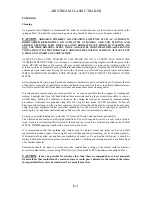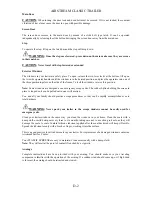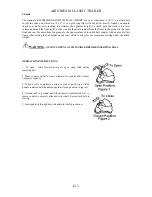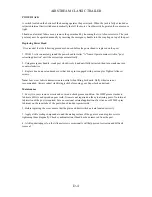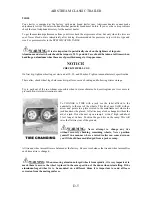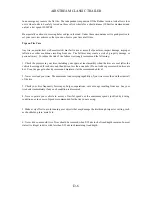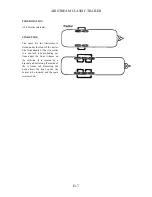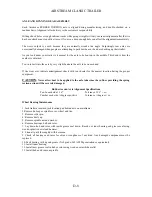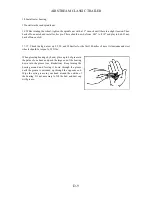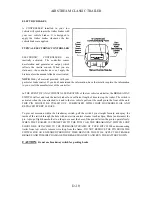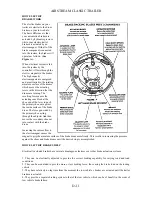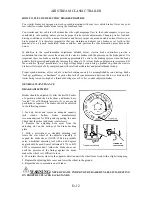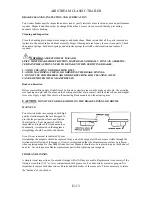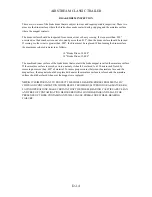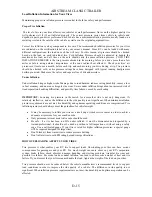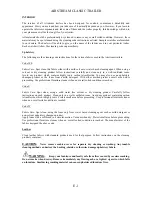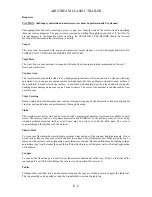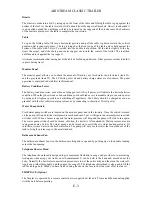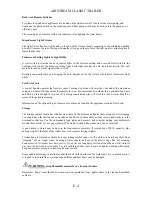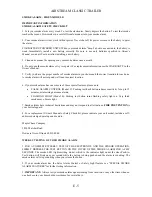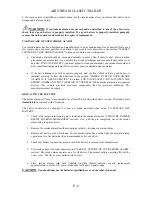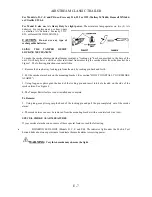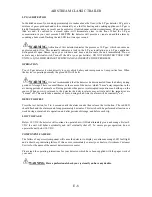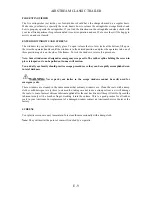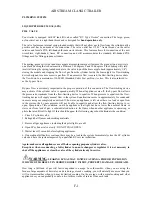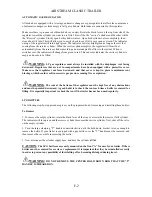
AIRSTREAM CLASSIC TRAILER
D-12
ECTRIC BRAKES PROPERLY
Your trailer brakes are designed to work in synchronization with your tow vehicle brakes. Never use your
tow vehicle or trailer brakes alone to stop the combined load.
Your trailer and tow vehicle will seldom have the right amperage flow to the brake magnets to give you
comfortable, safe braking unless you make proper brake system adjustments. Changing trailer load and
driving conditions as well as uneven alternator and battery output can mean unstable current flow to your
brake magnets. It is therefore imperative that you maintain and adjust your brakes as set forth in this
manual, use a properly modulated brake controller, and perform the synchronization procedure noted
below.
In addition to the synchronization adjustment detailed below, electric brake controllers provide a
modulation function that varies the current to the electric brakes with the pressure on the brake pedal. It is
important that your brake controller provide approximately 2 volts to the braking system when the brake
pedal is first depressed and gradually increase the voltage to 12 volts as brake pedal pressure is increased. If
the controller "jumps" immediately to a high voltage output, even during a gradual stop, then the electric
brakes will always be fully energized and will result in harsh brakes and potential brake lockup.
Proper synchronization of tow vehicle to trailer braking can only be accomplished by road testing. Brake
"lockup, grabbiness, or harshness" is quite often lack of synchronization between the tow vehicle and the
trailer being towed, too high of a threshold voltage (over 2 volts), or under adjusted brakes.
GENERAL MAINTENANCE
BRAKE ADJUSTMENT
Brakes should be adjusted (1) after the first 200 miles
of operation when the brake shoes and drums have
"seated", (2) at 3000-mile intervals, (3) or as use and
performance requires. The brakes should be adjusted
in the following manner:
1. Jack up trailer and secure on adequate capacity
jack stands. Follow trailer manufacturers
recommendations for lifting and supporting the unit.
Check that the wheel and drum rotates freely.
2. Remove the adjusting hole cover from the
adjusting slot on the bottom of the brake backing
plate.
3. With a screwdriver or standard adjusting tool
rotate the star wheel of the adjuster assembly to
expand the brake shoes. (NOTE: With drop spindle
axles a modified adjusting tool with an 80 degrees
angle should be used. Sears Craftsman # 4736 or K-D
#295 is recommended.) Adjust the brake shoes out
until the pressure of the linings against the drum
makes the wheel very difficult to turn.
4. Then rotate the star wheel in the opposite direction until the wheel turns freely with a slight lining drag.
5. Replace the adjusting hole cover and lower the wheel to the ground.
6. Repeat the above procedure on all brakes.
HOW TO USE YOUR EL
WARNING:
NEVER CRAWL UNDER YOUR TRAILER UNLESS IT IS RESTING
ON PROPERLY PLACED JACK STANDS.
Summary of Contents for Classic Trailer 25' 2005
Page 1: ...AIRSTREAM AN AMERICAN LEGEND CLASSIC TRAILER OWNERS MANUAL 2005...
Page 2: ......
Page 14: ...AIRSTREAM CLASSIC TRAILER A 9 MAINTENANCE RECORD DATE DEALER SERVICE PERFORMED...
Page 15: ...AIRSTREAM CLASSIC TRAILER A 10 NOTES...
Page 33: ...AIRSTREAM CLASSIC TRAILER B 18 NOTES...
Page 39: ...AIRSTREAM CLASSIC TRAILER C 6 NOTES...
Page 58: ...AIRSTREAM CLASSIC TRAILER D 16 OTES N...
Page 72: ...AIRSTREAM CLASSIC TRAILER F 5 YPICAL GAS LINE SYSTEM T...
Page 113: ...AIRSTREAM CLASSIC TRAILER G 19...
Page 124: ...Notes...
Page 125: ......
Page 126: ......


